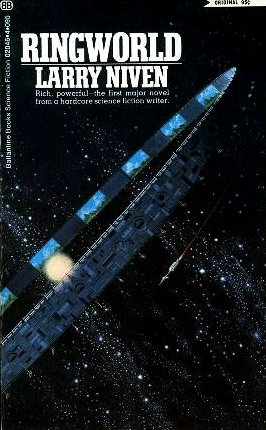 Speculation about technologically-superior, alien life is abundant in science fiction. Novels such as Larry Nivan’s Ringworld, video games such as Halo, and a TV episode of Star Trek – The Next Generation depict solar-system-scale structures (megastructures) built by incredibly-advanced, intelligent civilizations. Theoretical physicist Freeman Dyson proposed that increasing energy demands would lead extraterrestrial civilizations to build larger and larger structures to capture the energy from their star. This might culminate in a “Dyson Sphere”, a megastructure that would completely or nearly completely enshroud the central star of the civilization’s solar system. The episode “Relics” in the Star Trek the Next Generation series depicts a Dyson Sphere. Larry Nivan’s multiple-award winning novel Ringworld imagines a slightly less grand megastructure, a million-mile-wide ribbon that circles a star at the distance separating the earth and sun – ninety three million miles. The video game Halo takes place and is named after smaller versions of the ringworld megastructure.
Speculation about technologically-superior, alien life is abundant in science fiction. Novels such as Larry Nivan’s Ringworld, video games such as Halo, and a TV episode of Star Trek – The Next Generation depict solar-system-scale structures (megastructures) built by incredibly-advanced, intelligent civilizations. Theoretical physicist Freeman Dyson proposed that increasing energy demands would lead extraterrestrial civilizations to build larger and larger structures to capture the energy from their star. This might culminate in a “Dyson Sphere”, a megastructure that would completely or nearly completely enshroud the central star of the civilization’s solar system. The episode “Relics” in the Star Trek the Next Generation series depicts a Dyson Sphere. Larry Nivan’s multiple-award winning novel Ringworld imagines a slightly less grand megastructure, a million-mile-wide ribbon that circles a star at the distance separating the earth and sun – ninety three million miles. The video game Halo takes place and is named after smaller versions of the ringworld megastructure.
Last month newspapers around the world ran provocative headlines reading, for example, “Astronomers find ‘Alien Megastructures’” and “Are Those Really Alien Megastructures?” The reason for the excitement is the publication of a detailed analysis of the variation in the brightness of the star named KIC 8462852 recorded over a several years by NASA’s Kepler telescope. The planet-finding satellite stares at the same area of the sky, carefully measuring the brightness of Milky Way stars. Sophisticated computer algorithms look for the occasional dip in the brightness that is caused by a planet in its solar system passing directly between us and the star. In addition to the computers, human eyes examine the data in a people-powered, crowd-sourced analysis. Anyone can log onto Zooniverse and contribute to the analysis of the Kepler data. Occasionally, odd variations are found that a computer discards. Most of the variations that Kepler detects can be explained by planets or star spots or some other phenomenon. In the case of KIC 8462852, human eyes spotted large, aperiodic dips in the intensity of the star light. None of the usual suspects would adequately explain the extreme drops in the star’s brightness tagged by amateur astronomers on Zooniverse.
The scientific paper released in advance of publication on October 15th reports follow-up observations and systematically examines several possible causes for the irregular variability of this strange star. The authors settle on a very unusual swarm of comets being the most likely cause of the unprecedented brightness fluctuations. This may have been caused by a violent collision of planets in this exo-solar system. While not mentioned in the paper to be published in the Monthly Notices of the Royal Astronomical Society some of the authors suggested that another explanation might be considered. Specifically, instead of a comet swarm, they speculate that the star’s light may be obscured by an alien megastructures, similar to a ringworld.
A ringworld, or similar engineering marvel, seems to be a wondrously creative concept. Ironically, a solar-system-scale megastructure actually represents a failure of our imagination. A megastructure results from following the path of our current technology and resulting patterns of consumption. However, as the current state of our climate testifies, this path is not sustainable. Megastructures represent the ultimate extrapolation of current unsustainable practices. Undoubtedly the path we follow dead ends long before we could hope to build a megastructure. So, while it is exciting to wonder about the mysterious variability of KIC 8462852, an alien megastructure is not only a very unlikely candidate for its explanation but also illustrates the need for more creative solutions when we envision the future advancement of our civilization or even our dreams of advanced alien civilizations.
In his Threshold lecture last month, Roman Verostko, computer art pioneer, spoke of the physical leverage that ancient humans gained with tools like a hatchet. During Verostko’s career, computer technology was developed that provided mental leverage, moving our civilization in directions previously not considered. While our anc ient cave-dwelling ancestors might have envisioned a future of megahatchets or megacaves in the heavens, we dream of ringworlds. New forms of leverage, perhaps technological, but also economic, moral, and political must move our civilization in new, unimagined directions if we are to find a sustainable path to the future. No doubt that an advanced alien civilization would have developed technology and consumption practices - perhaps even evolved biologically - so that a megastructure would not be needed for energy or resource production. We need to look for inspiration everywhere - in nature, art, science, fiction, poetry and prayer – if we are to find a path to a sustainable future for all.
ient cave-dwelling ancestors might have envisioned a future of megahatchets or megacaves in the heavens, we dream of ringworlds. New forms of leverage, perhaps technological, but also economic, moral, and political must move our civilization in new, unimagined directions if we are to find a sustainable path to the future. No doubt that an advanced alien civilization would have developed technology and consumption practices - perhaps even evolved biologically - so that a megastructure would not be needed for energy or resource production. We need to look for inspiration everywhere - in nature, art, science, fiction, poetry and prayer – if we are to find a path to a sustainable future for all.



 中国学生
中国学生 Estudiantes
Estudiantes




